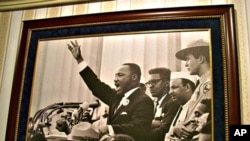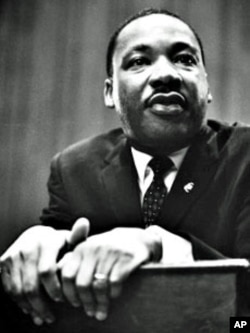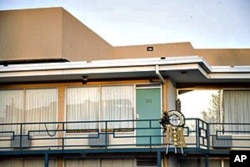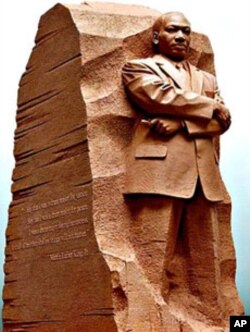Free at last, free at last; thank God Almighty, we are free at last. These words, in ringing oratory, are perhaps the most enduring image we have of Martin Luther King, Jr. His finale to a massive civil-rights march on Washington, D.C., in 1963, was delivered before a quarter of a million people in the shadow of Abraham Lincoln's statue on the National Mall. Forty-seven years later, as next Monday's American holiday that honors his birth approaches, the enduring power of what's remembered as the "I Have a Dream" speech still moves those who hear it.
The speech is ranked by many historians among the greatest orations, and most profound literature, in American history, alongside President Lincoln's "Gettysburg Address" during the American Civil War, Franklin Roosevelt's "Nothing to Fear but Fear Itself" speech during the Great Depression, and John F. Kennedy's "Ask What You Can Do for Your Country" inaugural address. Teachers and students everywhere dissect its language, cadence, and rhetorical techniques.
Speaking from his heart
Communications professor Margaret Zulick at Wake Forest University says that what makes this remarkable is that, halfway through, Mr. King completely abandoned his prepared text and never referred to it again. "There's a spot where there's actually an incomplete sentence, which is very rare for King," she notes. "And he misses a beat: 'I say to you today, my friends – so even though we face the difficulties of today and tomorrow . . . '"
Professor Zulick says the "I have a dream" part of King's speech, follows immediately after. "That was extemporaneous: 'I still have a dream,' to which the audience replies, enthusiastically, 'Yes!!!'"
King follows with more unscripted, dramatic repetitions of the now-legendary I have a dream phrase: "I have a dream that one day even the state of Mississippi, a state sweltering with the heat of injustice, sweltering with the heat of oppression, will be transformed into an oasis of freedom and justice."
"I have a dream," to which the audience reacts with more Yes's and applause.
Margaret Zulick at Wake Forest calls these repetitions riffs. Jazz musicians actually practice riffs, little improvisational sections, she says. "Then when they perform, part of the improvisation is kind of mixing and matching these bits and pieces that are in their repertoire. And that's exactly what he does."
Inspiring imagery
In the First Century A.D., the Roman orator Longinus described what he called sublime speechmaking. It not only perfectly fits the occasion but also lifts the audience beyond the excitement of the moment and inspires lasting change. Today many scholars lift high the "I Have a Dream" speech as the classic example of sublime oratory.
John Adams, a visiting professor of rhetoric at Hamilton College in New York state, says he's struck by King's lavish use of metaphors – unexpected words and ideas that create vivid images.
"It perfectly and poetically spoke to the urgency of the moment, this transcendent hope for justice and freedom," he says. "Take just the second paragraph, where he claims that the Emancipation Proclamation [declaring slaves free during the U.S. Civil War] came as a 'great beacon light of hope' to millions of people who had been 'seared in the flames of withering injustice.'"
John Adams says Martin Luther King Jr. used many light-and-dark, night-and-day analogies in the speech, such as, "It came as a joyous daybreak to end the long night of their captivity."
By setting out those contrasts, Professor Adams observes, you set an appetite for their resolution - the resolution of those tensions.
He cites other examples: "Manacles of segregation," "chains of discrimination," "people living on a lonely island of poverty in the midst of a vast ocean of material prosperity."
Other geographical allusions, about waters and mountains and valleys, abound as well: "Let us not wallow in the valley of despair."
John Adams says the entire speech, with its dream theme, is a metaphor. He says much of its power flowed from its delivery. Others may perform the speech, but none can match King's looks and gestures, rhythm and heartfelt sincerity.
Douglas DuBrin teaches English and history at the French International School outside Washington, D.C.. He uses the "I Have a Dream" speech in his classes and has prepared Internet lesson plans on it for other teachers. DuBrin says the speech has musical qualities, including these rousing refrains:
"Let freedom ring from the heightening Alleghenies of Pennsylvania."
"Let freedom ring from the snow-capped Rockies of Colorado."
And later . . .
"Let freedom ring from every hill and molehill of Mississippi. From every mountainside."
Masterful metaphors
Douglas DuBrin says King captured all four elements of a great speech, including eloquence. "King had a masterful way of choosing references that would inspire the audience: the prolonged metaphors, the moments that are extended, even the pauses that he uses while the people are cheering, his ability to sort of take the moment and go beyond it."
The next essential element: passion. Every bit of the speech seems to be from his fiber, from his heart:
"Let us not seek to satisfy our thirst for freedom by drinking from the cup of bitterness and hatred."
"King was a learned man, and his intellect was evident," Douglas DuBrin points out. "His references are ample to history, to the plight of various peoples."
Douglas DuBrin says the fourth ingredient of great speechmaking, persuasiveness, must be evaluated after the fact. He says the speech helped change the nation's racial landscape for the better.
Bridging the racial divide
While Martin Luther King made ample use of his skills as a hypnotic Baptist preacher, with calls to the audience and their response, dramatic pauses, and lyrical references to biblical passages, Margaret Zulick at Wake Forest University says the "I Have a Dream" speech endures because it bridged the racial divide. "He's trying to hold his own movement together, and then he's also trying to bring the movement into the mainstream and convince white Americans that 'all we're asking for is our own share of the American dream.' The Constitution and the Declaration of Independence were promissory notes for freedom and equality, 'and now we're cashing it in.'"
Very simply put, it's the idea that black Americans are Americans, and that America is not going to be America until white Americans understand that the black American tradition is their tradition.
In King's words: "We refuse to believe that the bank of justice is bankrupt. We refuse to believe that there are insufficient funds in the great vaults of opportunity of this nation."
As Martin Luther King Junior delivered his soaring "I Have a Dream" speech, Washington was half-deserted. hunkered down and anxious about what the tens of thousands of freedom marchers might do. King's forceful, yet reasoned, speech, which be began to write just four days before it was delivered, softened the nation's fear and anger and helped convince President Kennedy to begin the push for a landmark civil-rights act that would end government-sponsored racial segregation in much of the land.
President Kennedy would be assassinated less than three months later. And five years later, after delivering one of his last public utterances about having been to the mountaintop, King, too, would be felled by an assassin's bullet.











